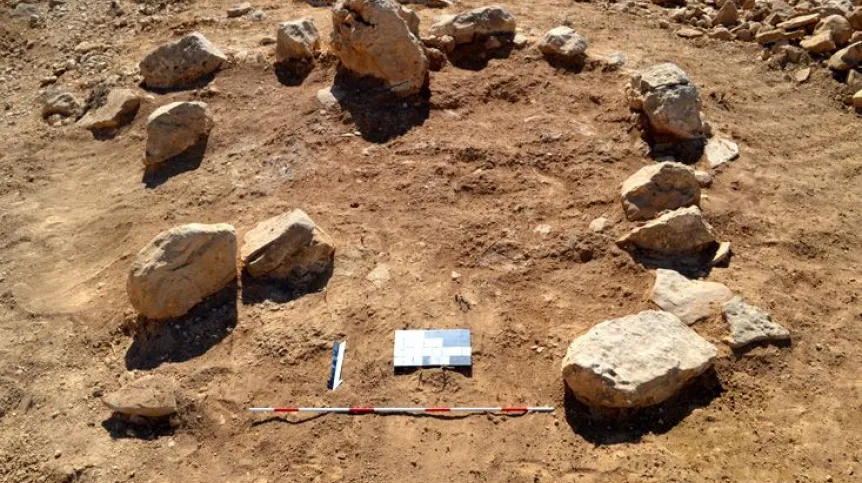
Fragments of ceramic and stone vessels, flint tools and metal objects have been brought from Jordan to Kraków by researchers from the Institute of Archaeology of the Jagiellonian University. The oldest items are nearly half a million years old.
The artefacts were discovered during extensive research in southern Jordan, near the village of At-Tafila.
"Some of the artefacts we brought are unique, which is why we are going to present them at an exhibition, which will be opened in December" - explained Head of the Krakow research expedition to Jordan, Dr. Piotr Kołodziejczyk from the Institute of Archaeology of the Jagiellonian University.
Scientist named primarily hand axes, or flint tools used by the ancestors of modern man almost half a million years ago, during the middle Paleolithic.
"In our collection we have 10 hand axes at various stages of preparation - some of them completed, some abandoned during processing. These are no such artefacts in Poland" - noted Dr. Kołodziejczyk.
The largest part of the collection are flint tools from different eras - a total of approx. 1,500 items, and approx. 1,500 pieces of pottery. Those come from the medieval period and are covered with painted decoration. Plastic decorations are visible on the earlier items.
Some of the artefacts from the collection will now be subjected to detailed laboratory analysis. Researchers want to determine the chemical composition of the ceramic vessels to identify the additives found in the mass from which they had been made. By analysing the flint tools, scientists will attempt to answer the question of the outcrop the material comes from. "The great benefit for scientific inquiry is that we can work on the material during the whole year, not just during the field expedition" - he added.
Comprehensive testing of the artefacts will allow to create the image of natural and cultural transformation in the Wadi Mashrano - Wadi Selim region, and describe human activity in the area. "We already know that it was significant and associated mainly with agriculture" - said the scientist.
Some of the relics found their way to the teaching collection at the Institute of Archaeology of the Jagiellonian University. "As a result, students will be able to learn on the original material. It\'s a whole new dimension of teaching" - said Dr. Kołodziejczyk.
Jordan is one of the few countries in the Middle East that allows the removal of monuments. The law in this area is particularly restrictive in Egypt; taking away specialist samples from there is a huge challenge for scientists. That is why in the case of Egypt radiocarbon analyses, for example, are usually performed in Cairo.
The first season of research in Jordan took place in 2014. Archaeologists are trying to trace local exchange mechanisms and routes frequented by ancient traders - this is an interesting area for this type of analysis, because in the area of southern Jordan was the capital of the Nabataeans - Petra and the so-called King\'s Road.
This year\'s work resulted in, among other things, the discovery of an unknown, Neolithic settlements (approx. 10 thousand years old) and probably Chalcolithic, megalithic structures (approx. 8 thousand years old), as well as many historical monuments. This season was unique for researchers, as they began excavations - earlier they had been conducting surface surveys that involved searching for fragments of pottery and old tools on the surface. Excavations were carried out in the picturesquely situated site Ain Sawan (southern Jordan), where 18 megalithic stone structures are located.
"They are a mystery to us. We believe that they were associated with the groups of nomads functioning here at the time and formed area markers or a cult symbol. They could be strongly linked to the local landscape or reflect the landforms known to their builders from other areas" - said Dr. Kołodziejczyk.
Artefacts from this place are also included in the collection brought to the Institute of Archaeology of the Jagiellonian University.
Another important discovery of the last season, which took place in October, is - according to archaeologists - locating, in cooperation with the Jordanian archaeologists, a previously unknown huge settlement from the Neolithic, Chalcolithic and Early Bronze Age in the region of Faysaliya.
"We will begin excavation there next year. But we already suspect that this will be one of the largest and most significant settlements from this period. The amount of structures and artefacts visible on the surface made us dizzy. The coming years and research in this place will probably result in great discoveries"- believes Dr. Kołodziejczyk.
PAP - Science and Scholarship in Poland, Szymon Zdziebłowski
szz/ mrt/
tr. RL













